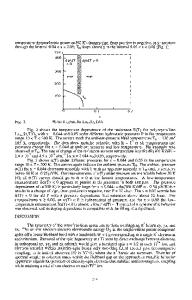Correlating Role of Substrate and Modified Physical Properties of (Bi 0.5 La 0.5 FeO 3 ) 1-x -(Ba 0.7 Sr 0.3 TiO 3 ) x (
- PDF / 1,815,454 Bytes
- 9 Pages / 595.276 x 790.866 pts Page_size
- 74 Downloads / 364 Views
ORIGINAL PAPER
Correlating Role of Substrate and Modified Physical Properties of (Bi0.5La0.5FeO3)1-x-(Ba0.7Sr0.3TiO3)x (x = 0, 0.5) Thin Films S. Vansutre 1,2 & S. Radha 2 & C. L. Prajapat 3 & A. Verma 4 & H. Bhatt 5 & S. D. Kaushik 6 Received: 5 July 2020 / Accepted: 4 September 2020 # Springer Science+Business Media, LLC, part of Springer Nature 2020
Abstract Bi0.5La0.5FeO3 and its solid solution with 50% Ba0.7Sr0.3TiO3 doping [(Bi0.5La0.5FeO3)0.5-(Ba0.7Sr0.3TiO3)0.5] were deposited on MgO and Si substrates by employing pulse laser deposition; these samples were investigated by X-ray diffraction (XRD), field emission scanning electron microscopy (FESEM), electron dispersive study, infrared (IR) spectroscopy and magnetization measurement. XRD data confirms the formation of the sample in the thin film form. The average grain size was calculated from the XRD data, and the estimation of the microstrain was made by employing Williamson–Hall (W-H) formulation. The estimation of the grain size was confirmed by the FESEM images. The modifications in the IR absorption spectra and the room temperature magnetization due to differing substrates are correlated with the microstrain in thin film. The modification in the physical property offers the opportunity of optimizing the properties by selecting the substrate for potential technological application. Keywords Thin film . Grain size . Microstrain . Magnetization . IR spectroscopy . FESEM
1 Introduction Multiferroic (MF) compounds are those “smart” materials that exhibit more than one of the three widely known ferroic orders, i.e., (anti)ferromagnetic, ferroelectric or ferroelastic [1–4]. The strength of coupling between any two of these orders, often termed as magnetoelectric/magnetoelastic, may pave the way for the development of multifunctional * S. Radha [email protected] * S. D. Kaushik [email protected] 1
S.I.W.S. College, Wadala, Mumbai 400031, India
2
Department of Physics, University of Mumbai, Mumbai 400098, India
3
Technical Physics Division, BARC, Trombay, Mumbai 400085, India
4
Mechanical Metallurgy Division, BARC, Trombay, Mumbai 400085, India
5
High Pressure & Synchrotron Radiation Physics Division, BARC, Trombay, Mumbai 400085, India
6
UGC-DAE CSR Mumbai Centre, BARC Campus, Trombay, Mumbai 400085, India
properties in MF materials. Majority of these compounds exhibit MF property only at low temperatures [5, 6]. The scarcity of such compounds with MF properties at room temperature has intensified the research in the field of multiferroicity [7, 8]. Among these materials, BiFeO3 (BFO) is one of the rare compound exhibiting MF behaviour, with room temperature ferroelectric (TC ~ 1100 K) and magnetic (TN ~ 640 K) ordering, and this is probably the reason that BFO is one of the most studied compound in recent times [9–17]. Bulk BFO shows distorted rhombohedral crystal structure (space group R3c) and a spin modulated cycloidal magnetic structure with modulated periodicity ≈ 62 nm [10–18] at room temperature. The large difference between the
Data Loading...










